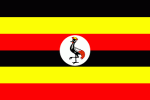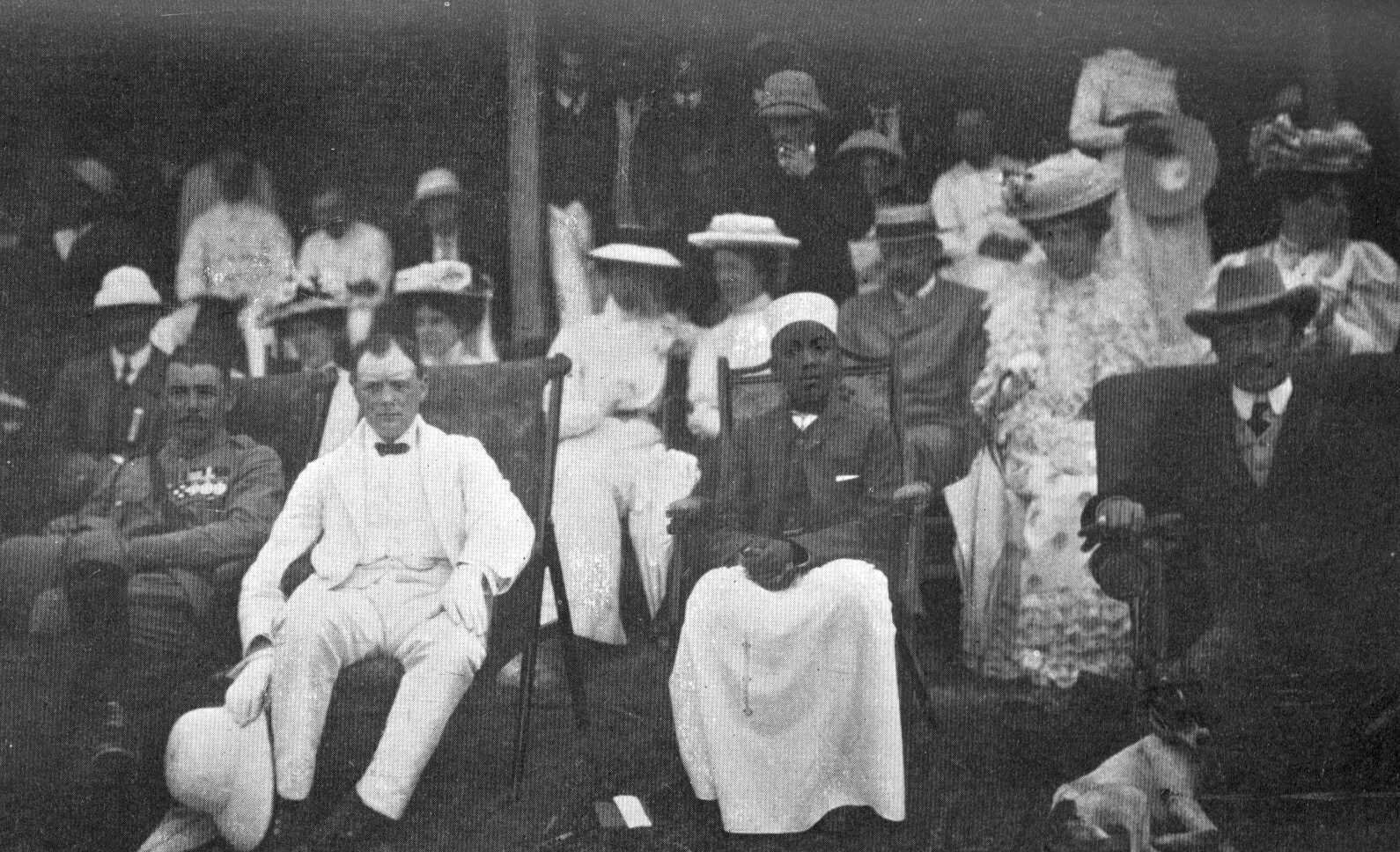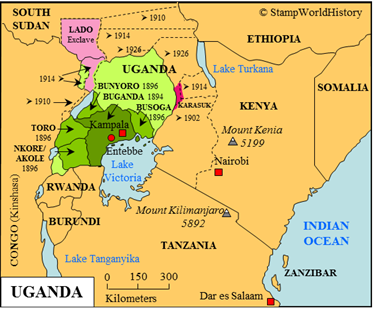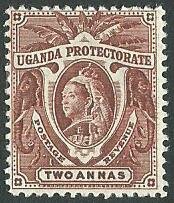
Uganda
British protectorate

Uganda
Republic
Quick reference
General issues: British protectorate 1895-1902, British protectorate, self government 1962, Independent within the British Commonwealth 1962-1967, Republic 1967-Present
Country name on general issues: UG, Uganda
Currency: 1 Penny = 12½ Kauri 1895-1897, 1 Rupee = 16 Anna 1897-1902, 1 (Uganda) Shilling = 100 Cent 1962-Present
Population: 1 649 000 in 1903, 37 580 000 in 2013
Political history Uganda
The colonial era
Uganda is located in eastern Africa. In the mid 19th century, in the southern part of Uganda, a number of kingdoms have been established by Bantu peoples. The Nilo-Saharan peoples living in the northern part of the country are less centrally organized. From 1890, Uganda is part of the British sphere of influence as agreed at the 1885 Berlin conference where the colonial powers have divided their respective spheres of influence in Africa – a division that is further defined in an additional 1890 treaty between Germany and Great Britain, more specifically on eastern Africa.
From 1890, the British East Africa Company – a chartered company – will deploy its activities in Uganda. As the British East Africa Company does not manage to make its activities profitable, the charter is revoked in 1893. The British government now takes things into its own hands. In 1894, the largest centrally located kingdom – the kingdom of Buganda – becomes a British protectorate. Buganda in Swahili – the lingua franca in eastern Africa – is called Uganda and, as such, has given its name to all of the country as we know it today. In 1896, the other smaller kingdoms follow suit. The rest of the country is brought under British control in subsequent years – a process that will, in some parts in the north of Uganda, take until 1918.
The borders of Uganda are adjusted several times. In 1902, 1914 and 1926, parts of Uganda are transferred to British Kenya. The borders with Sudan[1]Currently South Sudan. – at the time, an Anglo-Egyptian condominium – are adjusted in 1910, 1914 and 1926. Finally, the borders with Belgian Congo are adjusted in 1910, and again in 1914 when Uganda also gains the southern part of the Lado exclave that had been leased to Belgian Congo. All in all, the current orders are not established until 1926.
A special political arrangement has applied to the Karasuk area that, from 1930 until 1970, has been – although part of Kenya – administered by Uganda. The Suk are a people that, for a large part, live in Uganda and, as a small minority in Kenya, felt threatened.
The East African Community

1907 – Winston Churchill, Under-Secretary of State for the Colonies, meeting King Daudi Cwa II of Buganda in Kampala.
Uganda and neighboring Kenya – until 1920 British East Africa – have long cooperated in several ways. A postal union is formed in 1901. The cooperation is extended to include Tanganyika in 1930 and Zanzibar in 1964 when it joins with Tanganyika in the federation of Tanganyika & Zanzibar that will become Tanzania. The cooperation through the years goes by different names, from 1967 by that of the East African Community. The East African Community is dissolved in 1977.
Independent Uganda
In 1961, Uganda gains self government to become independent within the British Commonwealth in 1962. In 1967, Uganda becomes a republic. At this occasion, the kingdoms – that have, throughout the colonial era, played a role in the administration of Uganda – are abolished. The kingdoms will be reinstated with a certain amount of self government in 1993.
Uganda, after independence, will know periods with a democratic multi party political system and also periods with – military – dictatorships. Tensions between the population groups plunge the country into civil war from 1981 to 1986. In its foreign policy, Uganda will engage in war with Tanzania from 1978 to 1979 – the war ending in the status quo ante bellum. From 1996 to 2002, Uganda will be one of the countries involved in the wars in neighboring Congo.
Postal history Uganda
The first stamps to be used in Uganda are the issues of the British East Africa Company from 1890 – used both in British East Africa and Uganda. Specifically for Uganda, stamps are issued from 1895 – these being typewritten. The face value is in cowries – the shell money used in parts of Uganda. The first definitives are issued in 1898, now in rupee and annas.
The issues of Uganda are superseded by the joint issues of British East Africa & Uganda from 1902. Joint issues will continue to be issued until the East African Community is dissolved in 1977: from 1922 as Kenya & Uganda, from 1935 as Kenya, Uganda & Tanganyika, from 1964 as Kenya, Uganda, Tanganyika & Zanzibar and from 1965 until 1977 as Kenya, Uganda & Tanzania.
Uganda issues its first stamps as an individual country in 1962 after it has gained self government in 1961. The Uganda issues are, until 1977, used concurrently with the joint issues of Kenya, Uganda & Tanganyika – later Tanzania. The issues of each of these individual countries – Tanganyika and Kenya will also issue stamps from 1961 and 1963 respectively – are valid for use in all cooperating countries and even available in the other countries the first two weeks after they have been issued.
Album pages
← Previous page: Ubangi-ShariNext page: Upper Senegal & Niger →




